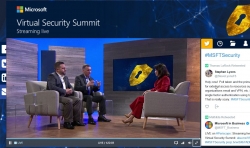Replacing Symantec certificates
Monday, March 19. 2018
Little bit of background about having certificates
A quote from https://www.brightedge.com/blog/http-https-and-seo/:
Google called for “HTTPS Everywhere” (secure search) at its I/O conference in June 2014 with its Webmaster Trends Analyst Pierre Far stating: “We want to convince you that all communications should be secure by default”
So, anybody with any sense in their head have moved to having their website prefer HTTPS as the communication protocol. For that to happen, a SSL certificate is required. In practice any X.509 would do the trick of encryption, but anybody visiting your website would get all kinds of warnings about that. An excellent website having failing certificates is https://badssl.com/. The precise error for you would see having a randomly selected certificate can be demonstrated at https://untrusted-root.badssl.com/.
Google, as the industry leader, has taken a huge role in driving certificate business to a direction it seems fit. They're hosting the most used website (google.com, according to https://en.wikipedia.org/wiki/List_of_most_popular_websites) and the most used web browser (Chrome, according to https://en.wikipedia.org/wiki/Usage_share_of_web_browsers). So, when they say something, it has a major impact to the Internet.
What they have said, is to start using secured HTTP for communications. There is an entire web page by Google about Marking HTTP As Non-Secure, having the timeline of how every single website needs to use HTTPS or risk being undervalued by GoogleBot and being flagged as insecure to web browsing audience.
Little bit of background about what certificates do
Since people publishing their stuff to the Net, like me, don't want to be downvalued or flagged as insecure, having a certificate is kinda mandatory. And that's what I did. Couple years ago, in fact.
I have no interest in paying the huge bucks for the properly validated certificates, I simply went for the cheapest possible Domain Validated (DV) cert. All validation types are described in https://casecurity.org/2013/08/07/what-are-the-different-types-of-ssl-certificates/. The reasoning, why in my opinion, those different verification types are completely bogus can be found from my blog post from 2013, HTTP Secure: Is Internet really broken?. The quote from sslshopper.com is:
"SSL certificates provide one thing, and one thing only: Encryption between the two ends using the certificate."
Nowhere in the technical specifcation of certificates, you can find anything related to actually identifying the other party you're encrypting your traffic with. A X.509 certificate has attributes in it, which may suggest that the other party is who the certificate says to be, but's an assumption at best. There is simply no way of you KNOWING it. What the SSL certificate industry wants you to believe, is that they doing all kinds of expensive verification makes your communications more secure. In reality it's just smoke and mirrors, a hoax. Your communications are as well encrypted using the cheapest or most expensive certificate.
Example:
You can steal a SSL certificate from Google.com and set up your own website having that as your certificate. It doesn't make your website Google, even the certificate so suggests.
Little bit of background about Symantec failing to do certificates
Nobody from Symantec or its affiliates informed me about this. Given, that I follow security scene and bumped into news about a dispute between Google and Symantec. This article is from 2015 in The Register: Fuming Google tears Symantec a new one over rogue SSL certs. A quote from the article says:
On October 12, Symantec said they had found that another 164 rogue certificates had been issued
in 76 domains without permission, and 2,458 certificates were issued for domains that were never registered.
"It's obviously concerning that a certificate authority would have such a long-running issue
and that they would be unable to assess its scope after being alerted to it and conducting an audit,"
So, this isn't anything new here. This is what all those years of fighting resulted as: Replace Your Symantec SSL/TLS Certificates:
Near the end of July 2017, Google Chrome created a plan to first reduce and then remove trust (by showing security warnings in the Chrome browser) of all Symantec, Thawte, GeoTrust, and RapidSSL-issued SSL/TLS certificates.
And: 23,000 HTTPS certs will be axed in next 24 hours after private keys leak.
In short:
They really dropped the ball. First they issued 164 certificates, which nobody actually ordered from them. Those rogue certificates included one for google.com. Then they somehow "lost" 23k private keys for already issued certificates.
That's really unacceptable for a company by their own words is "Global Leader In Next-Generation Cyber Security". That's what Symantec website https://www.symantec.com/ says, still today.
What next?
Symantec has a website called Check your website for Chrome distrust at https://www.websecurity.symantec.com/support/ssl-checker.
I did check the cert of this blog, and yup. It flagged the certificate as one needing immediate replacement. The certificate details have:
Certificate:
Data:
Version: 3 (0x2)
Serial Number:
24:6f:ae:e0:bf:16:8d:e5:7a:13:fb:bd:1e:1f:8d:a1
Signature Algorithm: sha256WithRSAEncryption
Issuer: C=US, O=GeoTrust Inc., CN=RapidSSL SHA256 CA
Validity
Not Before: Nov 25 00:00:00 2017 GMT
Not After : Feb 23 23:59:59 2021 GMT
Subject: CN=blog.hqcodeshop.fi
That's a GeoTrust Inc. issued certificate. GeoTrust is a subsidiary of Symantec. I did study the history of Symantec' certificate business and back in 2010 they acquired Verisign's certificate business resulting as ownership of Thawte and GeoTrust. RapidSSL is the el-cheapo brand of GeoTrust.
As instructed, I just re-issued the existing certificate. It resulted in:
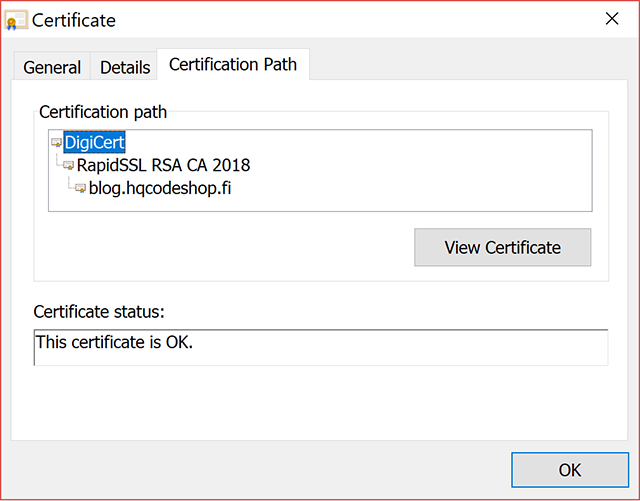
Now, my certificate traces back to a DigiCert CA root.
That's all good. I and you can continue browsing my blog without unnecessary this-website-is-not-secure -warnings.
Xyloband - What's inside one
Sunday, March 18. 2018
If you're lucky enough to get to go to a really cool event, it may be handing out a Xyloband to everybody attending it.
For those who've never heard of a Xyloband, go see their website at http://xylobands.com/. It has some sample videos, which this screenshot was taken from:

See those colourful dots in the above pic? Every dot is a person having a Xyloband in their wrist.
As you can see, mine is from King's Kingfomarket, Barcelona 2017. There is an YouTube video from the event, including some clips from the party at https://youtu.be/lnp6KjMRKW4. In the video, for example at 5:18, there is our CEO having the Xyloband in his right wrist and 5:20 one of my female colleagues with a flashing Xyloband. Because the thing in your wrist can be somehow remote controlled, it will create an extremely cool effect to have it flashing to the beat of music, or creating colourful effects in the crowd. So, ultimately you get to participate in the lighting of the venue.
After the party, nobody wanted those bands back, so of course I wanted to pop the cork of one. I had never even heard of such a thing and definitely wanted to see what makes it tick. Back of a Xyloband has bunch of phillips-head screws:
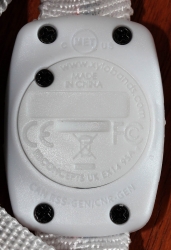
Given the size of the circular bottom, a guess that there would be a CR2032 battery in it is correct:
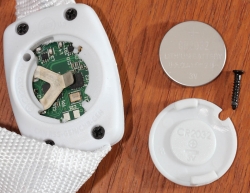
After removing the remaining 4 screws, I found two more CR2016 batteries:
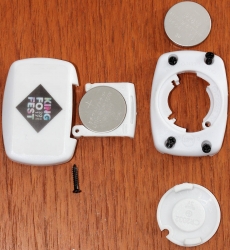
The pic has only two batteries visible, but the white tray indeed has two cells in it. Given the spec of a button cell (https://en.wikipedia.org/wiki/Button_cell), for a CR-battery it says: diameter 20 mm, height 3.2 mm. So, if you need 6 VDC voltage instead of the 3 VDC a single cell can produce, just put two CR2016 instead of one CR2032. They will take exactly the same space than a CR2032, but will provide double the voltage. Handy, huh! My thinking is, that 9 VDC is bit high for a such a system. But having a part with 6 volts and another part with 3 volts would make more sense to me.
Plastic cover removed, the board of a Xyloband will look like this:
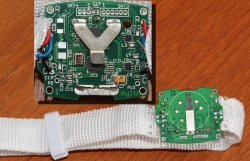
Nylon wristband removed, there is a flexing 4-wire cable having 8 RBG LEDs in it:
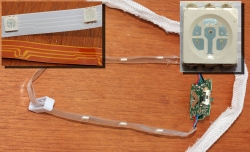
The circuits driving the thing are:
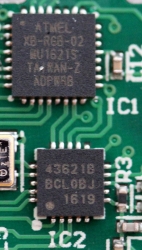
Upper one is an Atmel PLCC-32 chip with text Atmel XB-RBG-02 in it. If I read the last line correctly, it says ADPW8B. Very likely a 8-bit Microcontroller Atmel tailored for Xylobands to drive RBG-leds.
The radiochip at the bottom is a Silicon Labs Si4362. The spec is at https://www.silabs.com/documents/public/data-sheets/Si4362.pdf. A quote from the spec says:
Silicon Labs Si4362 devices are high-performance, low-current receivers covering the sub-GHz frequency bands from 142 to 1050 MHz. The radios are part of the EZRadioPRO® family, which includes a complete line of transmitters, receivers, and transceivers covering a wide range of applications.
Given this, they're just using Silicon Labs off-the-shelf RF-modules to transmit data to individual devices. This data can be fed into the Microcontroller making the RBG LEDs work how DJ of the party wants them to be lit.
While investigating this, I found a YouTube video by Mr. Breukink. It is at https://youtu.be/DdGHo7BWIvo?t=1m33s. He manages to "reactivate" a different model of Xylobands in his video. Of course he doesn't hack the RF-protocol (which would be very very cool, btw.), but he makes the LEDs lit with a color of your choosing. Of course on a real life situation when driven by the Atmel chip, the RBG leds can produce any color. Still, nice hack.
Microsoft Virtual Security Summit
Wednesday, March 14. 2018
I got and ad from Microsoft about a security summit they were organizing. Since it was virtual, I didn't have to travel anywhere and the agenda looked interesting, I signed up.
Quotes:
- Michael Melone, Microsoft
- Jim Moeller, Microsoft, about infosec referring to Michael Melone sitting next to him
- Patti Chrzan, Microsoft
Discussion points:
- Security hygiene
- Run patches to make your stuff up-to-date
- Control user's access
- Invest into your security, to make attackers ROI low enough to attack somebody else
- Security is a team sport!
- Entire industry needs to share and participate
- Law enforcement globally needs to participate
- Attacks are getting more sophisticated.
- 90% of cybercrime start from a sophisticated phishing mail
- When breached, new malware can steal domain admin's credentials and infect secured machines also.
- Command & control traffic can utilize stolen user credentials and corporate VPN to pass trough firewall.
- Attackers are financially motivated.
- Ransomware
- Bitcoin mining
- Petaya/Notpetaya being an exception, it just caused massive destruction
- Identity is the perimeter to protect
- Things are in the cloud, there is no perimeter
- Is the person logging in really who he/she claims to be?
- Enabling 2-factor authentication is vital
Finally:
Azure payment failure
Thursday, March 8. 2018
Since last July, this blog has been running in Microsoft Azure.
In January, Microsoft informed me, that I need to update my payment information or they'll cut off my service. Ever since, I've been trying to do that. For my amazement, I still cannot do it! There are JavaScript errors in their payment management panel, which seem to be impossible to fix.
So, eventually I got a warning, that they will discontinue my service unless I pay. Well ... I'd love to pay, but ... ![]() For the time being, all I can do is backup the site and plan for setting up shop somewhere else. This is so weird!
For the time being, all I can do is backup the site and plan for setting up shop somewhere else. This is so weird!

